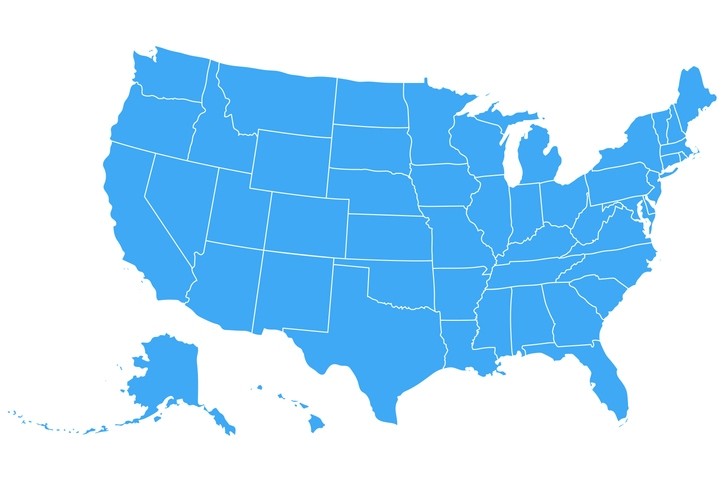Declines continue in US alcohol – but analyzing the market at a state level reveals opportunities

The US beverage alcohol market continued to shrink in the first seven months of 2024, with volumes declining more than expected.
The IWSR has compiled state-by-state data for the beverage alcohol market over the last five years and put it into its new US Navigator platform.
Looking local
Following the -2.6% decline in US total beverage alcohol (TBA) volumes recorded in 2023, IWSR forecasts had predicted a slight narrowing in 2024, with losses expected to moderate to -1.9%. However, total beverage alcohol volumes fell by -2.8% in the first seven months of the year.
All major categories except RTDs (volumes +2%) shrank (January - July 2024): with beer volumes falling -3.5%, spirits down -3% and wine declining by -4%.
However, a more nuanced picture emerges at the state level. A good example is New York, where spirits volumes only fell -1.5%. That’s compared to -3% for the US as a whole.
And while RTDs grew on a nationwide level, they actually fell -6.5% in New York.
That’s likely because New York’s strong cocktail culture and affluent urban base helped keeps spirits strong – but at the expense of RTDs.
That, says Marten Lodewijks, President of IWSR's US Division, illustrates why companies should look carefully at a state level.
“While national trends can transfer to individual states, there are nuances,” he told us.
“Population dynamics, for example, play a significant role for many categories. Hispanic consumers, for example, will often gravitate to different categories / brands so states with higher populations of Hispanic consumers will see those categories perform differently to states with lower concentrations.
“Weather can also play a significant factor with hotter, southern states seeing momentum in beer, for example, lasting later into the year than in colder, northern states where wine and spirits pick up earlier.
“The impact and influence of local or regional brands can also shift category dynamics between states. Local consumer preferences and cultural patterns will impact the market landscape, too. New York’s strong cocktail culture and affluent urban base, for example, are likely key drivers behind the performance of spirits vs RTDs and wine in New York. Similarly, we would see different category dynamics across other states.”
Key beverage alcohol stats
Beer saw volume fall -3.5% across the US, with almost all markets in decline. Some states, however, are posting smaller decreases, such as Florida, Texas and Pennsylvania, which all saw declines of less than -2%.
There are universal volume declines for spirits, but one or two brighter spots buck the overall trend. These include New York, Pennsylvania and North Carolina, which all also declined by less than -2% vs. the -3% national average.
RTDs are much more varied. While some states registered volume declines (Florida, New York and Michigan), others saw very robust growth, with standouts including Louisiana (+16%), South Dakota (+14%), Nebraska (+8%) and Minnesota (+6%).
The picture for wine remains ‘consistently gloomy’. Only New Mexico recorded a volume decline of less than -2%, and numerous markets shed more than 5% of their wine volumes between January and July, including Washington DC, Idaho, Kansas, Maryland and Oregon.
Tequila volumes declined by -1% in January-July 2024, due to a fall in consumption of ultra-premium (-8%) and standard (-3%) products, partially offset by gains for super-premium (+4%) and premium (+6%). Prestige-and-above tequilas of over $100 also continue to grow at over +6%.
While the trends hold across major states, there is a strong contrast between California and New York, where premiumisation is resilient (super-premium +10% and +5%, respectively) and Florida and Texas, which show only small gains for super-premium, but double-digit growth for premium.
That’s most likely driven by higher levels of disposable income in California and New York. And the category is still more of a novelty in the north-east compared to southern states, which are closer to Mexico and with higher concentrations of Hispanic consumers.
American whiskey volumes declined by -2% despite the fact that numerous states were effectively flat, including New York, Pennsylvania, Tennessee, Kentucky and Colorado.
The category’s major losses, however, came from its bigger, core markets such as California, Florida, Michigan and Texas.
Source: IWSR US Navigator.
Looking at the most populous states is one way to assess the opportunity for beverages. California, Texas, Florida and New York, therefore, can be expected to be good launchpads for new brands. But again, it’s not that simple.
“Population size can also be a key factor - California, Florida and New York tend to drive the majority of volumes in all categories due to their sheer size - but this can also mean a much more competitive landscape,” points out Lodewijks.
“Context matters and states behave in many ways like their own countries, so taking a local approach is critical in understanding trends.










